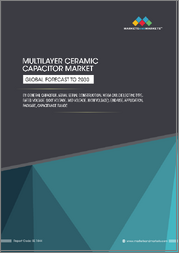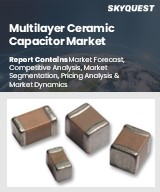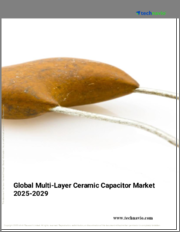
|
시장보고서
상품코드
1725129
세계의 적층 세라믹 커패시터(MLCC) 시장 : 유형별, 기기 유형별, 전압별, 실장별, 용도별, 최종 사용자별, 지역별 분석, 예측(-2032년)Multilayer Ceramic Capacitor Market Forecasts to 2032 - Global Analysis By Type (General-Purpose MLCCs, High-Reliability MLCCs and Low-ESR MLCCs), Equipment Type, Voltage, Mounting, Application, End User and By Geography |
||||||
Stratistics MRC에 따르면, 적층 세라믹 커패시터(MLCC) 세계 시장은 2025년에 117억 달러, 예측 기간 동안 CAGR은 8.2%를 나타낼 전망이고 2032년에는 204억 달러에 이를 전망입니다.
적층 세라믹 커패시터(MLCC)는 전기 에너지를 저장하고 조정하는 중요한 전자 부품입니다. 회로에 널리 사용되고 있습니다. MLCC는 고주파 동작에 대응해, 전압 변동에도 견딜 수 있기 때문에 가정용 전자 기기, 자동차, 산업 용도에 최적입니다.
ADAS(선진운전지원시스템)의 채택 증가
자동차 기술의 진화에 따라 실시간 처리 및 강화된 안전 기능을 지원하는 고신뢰성 커패시터에 대한 수요가 확대되고 있습니다. 무결성을 확보하는데 중요한 역할을 합니다. 자율주행차와 커넥티드카의 대두에 의해 MLCC의 채택이 급증해, 지능형 교통 시스템의 혁신을 지원할 것으로 예측됩니다.
원재료에 대한 높은 의존성과 가격 변동성
MLCC의 생산은 희토류 원소나 세라믹 화합물 등 특정 원재료에 크게 의존하고 있기 때문에 제조업체는 가격 변동의 영향을 받기 쉽습니다. 지정학적인 긴장이나 자원의 제약 등, 공급 체인에 혼란이 생기면, 생산 비용이나 공급력에 영향을 미칠 가능성이 있습니다.
산업 자동화 및 로봇 공학의 용도 증가
적층 세라믹 커패시터(MLCC)는 뛰어난 신뢰성, 소형화, 고주파 성능을 제공하기 위해 첨단 로봇 시스템과 스마트 공장의 운영에 최적입니다.
경기침체와 최종시장 수요 변동
경기후퇴는 일렉트로닉스 제조에 대한 투자를 감소시켜 MLCC 수요에 직접 영향을 미칠 가능성이 있습니다. 또한 자동차나 가전등의 업계에 있어서의 변동은 예측 불가능한 수요 사이클로 이어져, 제조업체의 수익의 안정성에 영향을 미칠 가능성이 있습니다. 글로벌 무역 정책과 인플레이션 압력을 둘러싼 불확실성은 시장 예측 및 비즈니스 전략에 복잡성을 더욱 가중시킵니다.
COVID-19의 영향 :
COVID-19의 유행은 MLCC 시장에 다각적인 영향을 주었으며 공급망과 소비자의 행동을 변화 시켰습니다. 초기 중단으로 인해 제조 중단과 물류 문제로 인한 공급 부족이 발생했지만, 이 위기는 여러 산업 분야에서 디지털화를 가속화하기도 했습니다. 원격 통신, 의료기기, 홈 오토메이션에 대한 의존도가 높아져 MLCC를 포함한 전자 부품에 대한 수요가 가속화되었습니다.
예측 기간 동안 범용 MLCC 부문이 최대가 될 전망
범용 MLCC 분야는 가전, 자동차, 산업 분야 등 폭넓은 용도가 있기 때문에 예측 기간 중에 최대 시장 점유율을 차지할 것으로 예측됩니다.
예측 기간 동안 디커플링 커패시터 분야의 CAGR이 가장 높을 것으로 예상
예측 기간 동안 디커플링 커패시터 분야는 전자회로에서 노이즈 저감과 안정된 전력 분배에 중요한 역할을 하는 것으로, 가장 높은 성장률을 나타낼 것으로 예측됩니다.
가장 높은 점유율이 있는 지역 :
예측 기간 동안 아시아태평양은 전자 제조 및 기술 발전의 강력한 존재로 인해 최대 시장 점유율을 차지할 것으로 예측됩니다. 뿐만 아니라 확립된 공급망과 대량 생산 능력의 혜택을 누리고 있습니다.
CAGR이 가장 높은 지역 :
예측기간 중 북미지역은 첨단기술과 반도체이노베이션에 대한 투자 증가에 힘입어 가장 높은 CAGR을 나타낼 것으로 예측됩니다.
무료 주문을 받아서 만드는 서비스 :
이 보고서를 구독하는 고객은 다음 무료 맞춤설정 옵션 중 하나를 사용할 수 있습니다.
- 기업 프로파일
- 추가 시장 기업의 종합적 프로파일링(3개사 까지)
- 주요 기업의 SWOT 분석(3개사 까지)
- 지역 세분화
- 고객의 관심에 응한 주요국 시장 추정, 예측 및 CAGR(주 : 타당성 확인에 따름)
- 경쟁 벤치마킹
- 제품 포트폴리오, 지리적 존재, 전략적 제휴에 기반한 주요 기업 벤치마킹
목차
제1장 주요 요약
제2장 서문
- 개요
- 이해관계자
- 조사 범위
- 조사 방법
- 데이터 마이닝
- 데이터 분석
- 데이터 검증
- 조사 접근
- 조사 자료
- 1차 조사 자료
- 2차 조사 정보원
- 전제조건
제3장 시장 동향 분석
- 성장 촉진요인
- 억제요인
- 기회
- 위협
- 용도 분석
- 최종 사용자 분석
- 신흥 시장
- COVID-19의 영향
제4장 Porter's Five Forces 분석
- 공급기업의 협상력
- 구매자의 협상력
- 대체품의 위협
- 신규 참가업체의 위협
- 경쟁 기업간 경쟁 관계
제5장 세계의 적층 세라믹 커패시터(MLCC) 시장 : 유형별
- 범용 MLCC
- 고신뢰성 MLCC
- 저 ESR MLCC
제6장 세계의 적층 세라믹 커패시터(MLCC) 시장 : 기기 유형별
- 클래스 1
- C0G(NP0) 커패시터
- C1G 커패시터
- 온도 안정성 커패시터
- 클래스 2
- X7R 커패시터
- X5R 커패시터
- Y5V 커패시터
제7장 세계의 적층 세라믹 커패시터(MLCC) 시장 : 전압별
- 저전압(최대 50V)
- 중전압(51V-500V)
- 고전압(500V 이상)
제8장 세계의 적층 세라믹 커패시터(MLCC) 시장 : 실장별
- 표면실장기술(SMT)
- 스루홀 기술
제9장 세계의 적층 세라믹 커패시터(MLCC) 시장 : 용도별
- 바이패스 커패시터
- 디커플링 커패시터
- 필터링
- 커플링
- 튜닝 회로
- 기타 용도
제10장 세계의 적층 세라믹 커패시터(MLCC) 시장 : 최종 사용자별
- 가전
- 자동차
- 산업기기
- 통신
- 기타 최종 사용자
제11장 세계의 적층 세라믹 커패시터(MLCC) 시장 : 지역별
- 북미
- 미국
- 캐나다
- 멕시코
- 유럽
- 독일
- 영국
- 이탈리아
- 프랑스
- 스페인
- 기타 유럽
- 아시아태평양
- 일본
- 중국
- 인도
- 호주
- 뉴질랜드
- 한국
- 기타 아시아태평양
- 남미
- 아르헨티나
- 브라질
- 칠레
- 기타 남미
- 중동 및 아프리카
- 사우디아라비아
- 아랍에미리트(UAE)
- 카타르
- 남아프리카
- 기타 중동 및 아프리카
제12장 주요 발전
- 계약, 파트너십, 협업, 합작투자
- 인수와 합병
- 신제품 발매
- 사업 확대
- 기타 주요 전략
제13장 기업 프로파일링
- Avatech
- Chaozhou Three-Circle
- Cornell Dubilier Electronics, Inc
- Fenghua Advanced Technology
- Future Electronics
- Illinois Capacitor, Inc
- Johanson Dielectrics, Inc.
- KYOCERA Corporation
- Murata Manufacturing Co., Ltd.
- Richardson Electronics, Ltd
- Samsung Electro Mechanics
- SEMCO
- Syfer Technology Limited
- Taiyo Yuden Co Ltd
- TDK Corporation
- Vishay Intertechnology, Inc.
- Walsin Technology Corporation
- YAGEO Group
According to Stratistics MRC, the Global Multilayer Ceramic Capacitor Market is accounted for $11.7 billion in 2025 and is expected to reach $20.4 billion by 2032 growing at a CAGR of 8.2% during the forecast period. Multilayer Ceramic Capacitor (MLCC) is an essential electronic component that stores and regulates electrical energy. Constructed with multiple layers of ceramic and metal electrodes, it provides high capacitance in a compact form. MLCCs are widely used in circuits for filtering, decoupling, and noise suppression due to their stability, reliability, and efficiency. They support high-frequency operations and withstand voltage fluctuations, making them ideal for consumer electronics, automotive, and industrial applications. As advancements in miniaturization and materials progress, MLCCs continue to enhance the performance of modern electronic devices, ensuring optimal functionality while maintaining durability and energy efficiency.
Market Dynamics:
Driver:
Increasing adoption in advanced driver-assistance systems (ADAS)
As automotive technology evolves, the demand for highly reliable capacitors that support real-time processing and enhanced safety features is expanding. These capacitors play a crucial role in stabilizing electronic circuits, ensuring consistent power delivery and signal integrity. With the rise of autonomous and connected vehicles, the adoption of MLCCs is expected to surge, supporting innovations in intelligent transportation systems.
Restraint:
High dependency on raw materials and price volatility
The production of MLCCs is highly reliant on specific raw materials, including rare earth elements and ceramic compounds, making manufacturers vulnerable to price fluctuations. Any disruption in the supply chain, whether due to geopolitical tensions or resource constraints, can impact production costs and availability. Additionally, sourcing high-quality materials while maintaining competitive pricing remains a challenge for industry players.
Opportunity:
Increasing applications in industrial automation and robotics
Multilayer ceramic capacitors offer superior reliability, miniaturization, and high-frequency performance, making them ideal for advanced robotic systems and smart factory operations. As industries transition towards automation-driven workflows, the demand for MLCCs is rising to support precision control and high-efficiency power management. The integration of AI and IoT in manufacturing is further fueling innovation, boosting the need for durable and efficient capacitors.
Threat:
Economic downturns and fluctuations in end-market demand
Economic downturns can result in reduced investments in electronics manufacturing, directly impacting MLCC demand. Additionally, volatility in industries such as automotive and consumer electronics can lead to unpredictable demand cycles, affecting revenue stability for manufacturers. The uncertainty surrounding global trade policies and inflationary pressures further adds complexity to market forecasting and business strategies.
Covid-19 Impact:
The COVID-19 pandemic had a multifaceted effect on the MLCC market, altering supply chains and consumer behaviors. While initial disruptions led to shortages due to manufacturing halts and logistical challenges, the crisis also accelerated digitalization across multiple industries. Increased reliance on remote communication, medical devices, and home automation spurred demand for electronic components, including MLCCs. However, raw material scarcity and transportation constraints posed hurdles, delaying production schedules.
The general-purpose MLCCs segment is expected to be the largest during the forecast period
The general-purpose MLCCs segment is expected to account for the largest market share during the forecast period due to their extensive applications across consumer electronics, automotive, and industrial sectors. Their cost-effectiveness, versatility, and reliability make them indispensable in circuit designs for smartphones, laptops, and home appliances. Additionally, continuous improvements in manufacturing techniques are enhancing their efficiency, further strengthening market adoption.
The decoupling capacitors segment is expected to have the highest CAGR during the forecast period
Over the forecast period, the decoupling capacitors segment is predicted to witness the highest growth rate driven by their critical role in noise reduction and stable power distribution in electronic circuits. As electronic systems become more complex with increasing power density, the demand for decoupling capacitors is soaring. Their ability to maintain voltage stability across integrated circuits is crucial for ensuring optimal device performance, making them a key component in high-frequency applications.
Region with largest share:
During the forecast period, the Asia Pacific region is expected to hold the largest market share owing to its strong presence in electronics manufacturing and technological advancements. Countries such as China, Japan, South Korea, and Taiwan are leading producers of MLCCs, benefitting from established supply chains and high-volume production capacities. The growing demand for smartphones, automotive electronics, and industrial automation solutions further supports regional market expansion.
Region with highest CAGR:
Over the forecast period, the North America region is anticipated to exhibit the highest CAGR propelled by increasing investments in advanced technologies and semiconductor innovations. The region's focus on electric vehicles, aerospace, and medical electronics is generating substantial demand for MLCCs. Additionally, government initiatives promoting domestic electronics production and R&D efforts in miniaturization technologies are fostering market growth.
Key players in the market
Some of the key players in Multilayer Ceramic Capacitor Market include Avatech, Chaozhou Three-Circle, Cornell Dubilier Electronics, Inc, Fenghua Advanced Technology, Future Electronics, Illinois Capacitor, Inc, Johanson Dielectrics, Inc., KYOCERA Corporation, Murata Manufacturing Co., Ltd., Richardson Electronics, Ltd, Samsung Electro Mechanics, SEMCO, Syfer Technology Limited, Taiyo Yuden Co Ltd, TDK Corporation, Vishay Intertechnology, Inc., Walsin Technology Corporation and YAGEO Group.
Key Developments:
In April 2025, TDK unveiled the Spin Photo Detector, a breakthrough in data transmission technology. This device achieves speeds up to ten times faster than current photodetectors, addressing AI data transfer bottlenecks. It utilizes magnetic tunnel junction (MTJ) technology and is expected to have applications in AR/VR, aerospace, and data centers.
In March 2025, Kyocera, in collaboration with Nitto Seimo, launched a trial of a smart-sensing research buoy powered by ocean currents, showcasing innovation in renewable energy applications.
In February 2025, Murata announced plans for significant mergers and acquisitions, potentially exceeding ¥100 billion (~$665 million), to expand in inductors and sensors. The company also plans to increase production capacity in Japan and Thailand and is preparing for manufacturing in India.
Types Covered:
- General-Purpose MLCCs
- High-Reliability MLCCs
- Low-ESR MLCCs
Equipment Types Covered:
- Class 1
- Class 2
Voltages Covered:
- Low Voltage (Up to 50V)
- Medium Voltage (51V - 500V)
- High Voltage (Above 500V)
Mountings Covered:
- Surface-Mount Technology (SMT)
- Through-Hole Technology
Applications Covered:
- Bypass Capacitors
- Decoupling Capacitors
- Filtering
- Coupling
- Tuning Circuits
- Other Applications
End Users Covered:
- Consumer Electronics
- Automotive
- Industrial Equipment
- Telecommunications
- Other End Users
Regions Covered:
- North America
- US
- Canada
- Mexico
- Europe
- Germany
- UK
- Italy
- France
- Spain
- Rest of Europe
- Asia Pacific
- Japan
- China
- India
- Australia
- New Zealand
- South Korea
- Rest of Asia Pacific
- South America
- Argentina
- Brazil
- Chile
- Rest of South America
- Middle East & Africa
- Saudi Arabia
- UAE
- Qatar
- South Africa
- Rest of Middle East & Africa
What our report offers:
- Market share assessments for the regional and country-level segments
- Strategic recommendations for the new entrants
- Covers Market data for the years 2024, 2025, 2026, 2028, and 2032
- Market Trends (Drivers, Constraints, Opportunities, Threats, Challenges, Investment Opportunities, and recommendations)
- Strategic recommendations in key business segments based on the market estimations
- Competitive landscaping mapping the key common trends
- Company profiling with detailed strategies, financials, and recent developments
- Supply chain trends mapping the latest technological advancements
Free Customization Offerings:
All the customers of this report will be entitled to receive one of the following free customization options:
- Company Profiling
- Comprehensive profiling of additional market players (up to 3)
- SWOT Analysis of key players (up to 3)
- Regional Segmentation
- Market estimations, Forecasts and CAGR of any prominent country as per the client's interest (Note: Depends on feasibility check)
- Competitive Benchmarking
- Benchmarking of key players based on product portfolio, geographical presence, and strategic alliances
Table of Contents
1 Executive Summary
2 Preface
- 2.1 Abstract
- 2.2 Stake Holders
- 2.3 Research Scope
- 2.4 Research Methodology
- 2.4.1 Data Mining
- 2.4.2 Data Analysis
- 2.4.3 Data Validation
- 2.4.4 Research Approach
- 2.5 Research Sources
- 2.5.1 Primary Research Sources
- 2.5.2 Secondary Research Sources
- 2.5.3 Assumptions
3 Market Trend Analysis
- 3.1 Introduction
- 3.2 Drivers
- 3.3 Restraints
- 3.4 Opportunities
- 3.5 Threats
- 3.6 Application Analysis
- 3.7 End User Analysis
- 3.8 Emerging Markets
- 3.9 Impact of Covid-19
4 Porters Five Force Analysis
- 4.1 Bargaining power of suppliers
- 4.2 Bargaining power of buyers
- 4.3 Threat of substitutes
- 4.4 Threat of new entrants
- 4.5 Competitive rivalry
5 Global Multilayer Ceramic Capacitor Market, By Type
- 5.1 Introduction
- 5.2 General-Purpose MLCCs
- 5.3 High-Reliability MLCCs
- 5.4 Low-ESR MLCCs
6 Global Multilayer Ceramic Capacitor Market, By Equipment Type
- 6.1 Introduction
- 6.2 Class 1
- 6.2.1 C0G (NP0) Capacitors
- 6.2.2 C1G Capacitors
- 6.2.3 Temperature-Stable Capacitors
- 6.3 Class 2
- 6.3.1 X7R Capacitors
- 6.3.2 X5R Capacitors
- 6.3.3 Y5V Capacitors
7 Global Multilayer Ceramic Capacitor Market, By Voltage
- 7.1 Introduction
- 7.2 Low Voltage (Up to 50V)
- 7.3 Medium Voltage (51V - 500V)
- 7.4 High Voltage (Above 500V)
8 Global Multilayer Ceramic Capacitor Market, By Mounting
- 8.1 Introduction
- 8.2 Surface-Mount Technology (SMT)
- 8.3 Through-Hole Technology
9 Global Multilayer Ceramic Capacitor Market, By Application
- 9.1 Introduction
- 9.2 Bypass Capacitors
- 9.3 Decoupling Capacitors
- 9.4 Filtering
- 9.5 Coupling
- 9.6 Tuning Circuits
- 9.7 Other Applications
10 Global Multilayer Ceramic Capacitor Market, By End User
- 10.1 Introduction
- 10.2 Consumer Electronics
- 10.3 Automotive
- 10.4 Industrial Equipment
- 10.5 Telecommunications
- 10.6 Other End Users
11 Global Multilayer Ceramic Capacitor Market, By Geography
- 11.1 Introduction
- 11.2 North America
- 11.2.1 US
- 11.2.2 Canada
- 11.2.3 Mexico
- 11.3 Europe
- 11.3.1 Germany
- 11.3.2 UK
- 11.3.3 Italy
- 11.3.4 France
- 11.3.5 Spain
- 11.3.6 Rest of Europe
- 11.4 Asia Pacific
- 11.4.1 Japan
- 11.4.2 China
- 11.4.3 India
- 11.4.4 Australia
- 11.4.5 New Zealand
- 11.4.6 South Korea
- 11.4.7 Rest of Asia Pacific
- 11.5 South America
- 11.5.1 Argentina
- 11.5.2 Brazil
- 11.5.3 Chile
- 11.5.4 Rest of South America
- 11.6 Middle East & Africa
- 11.6.1 Saudi Arabia
- 11.6.2 UAE
- 11.6.3 Qatar
- 11.6.4 South Africa
- 11.6.5 Rest of Middle East & Africa
12 Key Developments
- 12.1 Agreements, Partnerships, Collaborations and Joint Ventures
- 12.2 Acquisitions & Mergers
- 12.3 New Product Launch
- 12.4 Expansions
- 12.5 Other Key Strategies
13 Company Profiling
- 13.1 Avatech
- 13.2 Chaozhou Three-Circle
- 13.3 Cornell Dubilier Electronics, Inc
- 13.4 Fenghua Advanced Technology
- 13.5 Future Electronics
- 13.6 Illinois Capacitor, Inc
- 13.7 Johanson Dielectrics, Inc.
- 13.8 KYOCERA Corporation
- 13.9 Murata Manufacturing Co., Ltd.
- 13.10 Richardson Electronics, Ltd
- 13.11 Samsung Electro Mechanics
- 13.12 SEMCO
- 13.13 Syfer Technology Limited
- 13.14 Taiyo Yuden Co Ltd
- 13.15 TDK Corporation
- 13.16 Vishay Intertechnology, Inc.
- 13.17 Walsin Technology Corporation
- 13.18 YAGEO Group



















